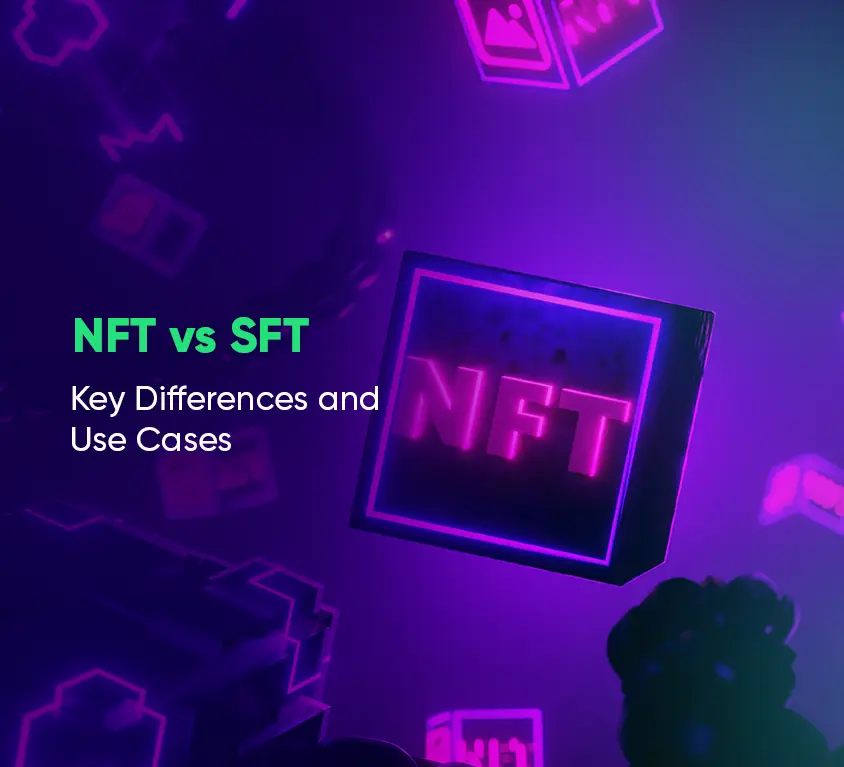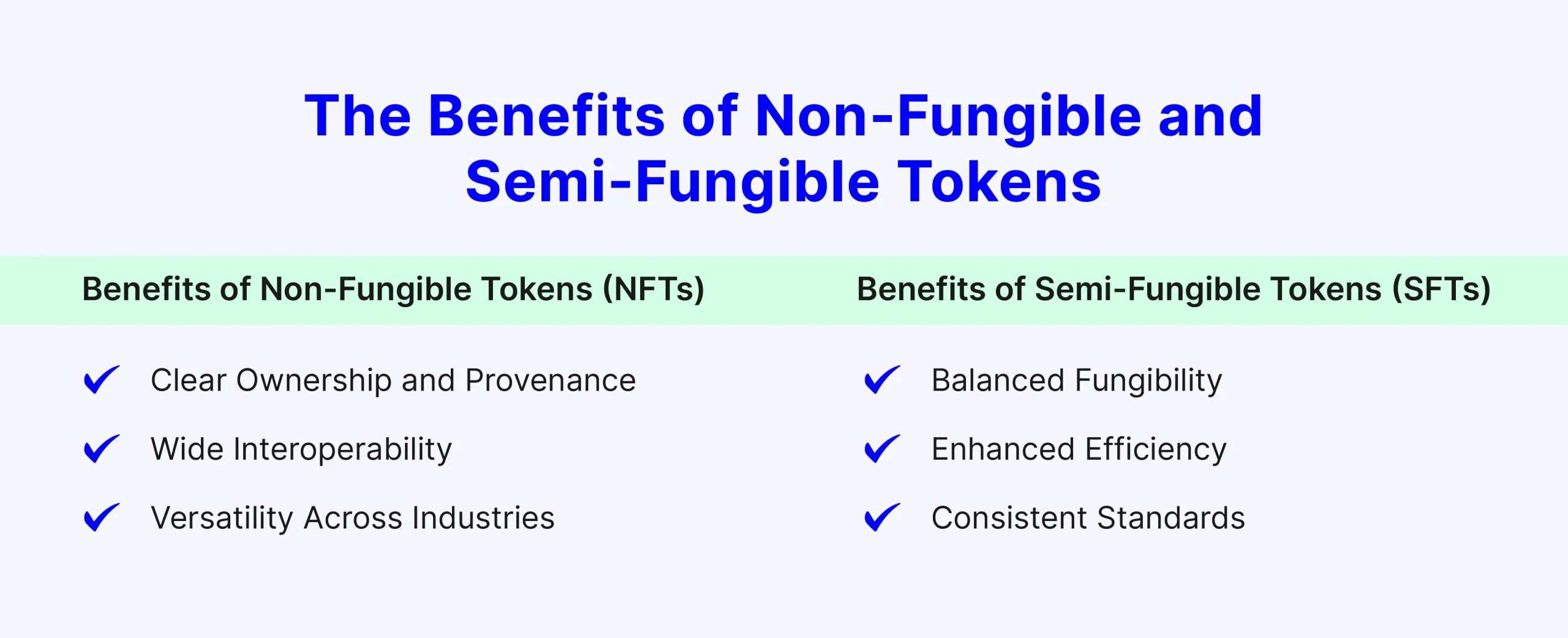
Introduction
Web3 & Blockchain Consultancy :
NFT vs SFT: Key Differences and Use Cases
The rise of blockchain technology has transformed the way we define ownership and authenticity in the digital world. Leading this transformation are the digital assets, which include non-fungible tokens (NFTs) and semi-fungible tokens (SFTs). Both these tokens are marked by their own distinct attributes and practical applications. This blog aims to unpack the complexities of NFTs and SFTs, offering insights into their functions, uses, benefits, and key features. We will also explore the differences between them, as well as their advantages and drawbacks.Key Takeaways
- Non-Fungible Tokens (NFTs): NFTs are unique digital assets stored on a blockchain. Each NFT has a distinct identity and cannot be replicated or divided.
- Semi-Fungible Tokens (SFTs): Semi-fungible tokens can operate both as fungible and non-fungible tokens depending on their use case.
- NFT vs SFT: The main difference between NFTs and SFTs is their interchangeability. NFTs are always unique and non-interchangeable, whereas SFTs start as interchangeable and can transition to become unique.
- Uses of NFTs & SFTs
- NFTs: Used in digital art for authenticity and ownership.
- SFTs: Common in ticketing where a ticket might convert to a collectible after an event.
What are Non-Fungible Tokens?
Non-fungible tokens (NFTs) are a unique category of digital assets that are both indivisible and distinctive. Each NFT stands alone, possessing characteristics that make it impossible to exchange on a one-to-one basis with other NFTs. These tokens are typically utilized to denote ownership of individual items or assets such as digital artwork, collectibles, and virtual real estate. The distinctiveness of each NFT is secured via blockchain technology, which assigns a unique cryptographic signature to every token.How Do Non-Fungible Tokens Function?
NFTs have transformed the ecosystem of digital ownership, introducing a novel method for establishing and tracking the ownership and provenance of unique digital items. Here’s a simplified explanation of how NFTs operate:Digital Asset Tokenization
The first step in creating an NFT is tokenizing a digital item. This could be anything from artwork to collectibles, to music. The process involves creating a unique blockchain-based token, or “minting,” that represents the digital asset.Immutable Blockchain Records
After an asset is tokenized, details of the NFT’s ownership are recorded on a blockchain, like Ethereum. These records are permanent and unchangeable, safeguarding the authenticity and ownership history of the asset.Smart Contracts
Smart contracts are essential to the functionality of NFTs. They establish the terms, such as ownership rights and creator royalties, under which the NFT operates. These contracts execute automatically during transactions, ensuring that creators receive royalties from secondary sales.Ownership Transfer
NFTs can be purchased, sold, or exchanged across various digital platforms and marketplaces. Each transaction results in an update to the blockchain, which reflects the change in ownership and ensures that the rights associated with the NFT are transferred accordingly.Interoperability Across Platforms
One of the key features of NFTs is their ability to transcend individual platforms. An NFT minted on one blockchain can often be sold or traded on another, enhancing their utility and allowing for a more diverse and flexible market.Where are non-fungible tokens used?
Non-fungible tokens (NFTs) have quickly become integral to numerous sectors, reshaping how we view and engage with digital assets. Here’s a look at some primary industries where NFTs are making a notable difference:Art and Collectibles
The art sector has been revolutionized by NFTs, enabling artists to tokenize their creations and offering collectors the chance to acquire verified, original pieces. This advancement has not only opened new opportunities for artists but also transformed the dynamics of art ownership.Gaming
The gaming industry has incorporated NFTs, allowing players to possess in-game items and characters as unique tokens. This addition enhances player involvement by enabling these assets to be traded on secondary markets, adding a new value dimension to gaming.Virtual Real Estate
In virtual worlds and metaverse platforms, there has been a boom in the sale of NFT-backed virtual land. Participants buy and develop these properties, similar to real-world real estate, fostering a burgeoning market for virtual land.Music and Entertainment
Artists in the music and entertainment fields are turning to NFTs to distribute music, tickets, and exclusive content directly to their audience. This model cuts out middlemen and helps ensure that creators receive appropriate compensation.Virtual Identities and Avatars
NFTs provide a means to craft and own distinct virtual identities and avatars within online environments and metaverse platforms, enhancing users’ sense of uniqueness and proprietary control.Digital Real Estate
In the realms of the metaverse and virtual reality, NFTs represent the ownership of digital lands and properties, with certain virtual spaces fetching high prices due to their perceived value.What are Semi-fungible tokens?
Semi-fungible tokens (SFTs) represent an intriguing hybrid between fungible and non-fungible assets. SFTs are essentially identical when it comes to their value and general attributes, yet they can also include unique features like serial numbers, giving them a degree of uniqueness not found in traditional fungible cryptocurrencies.How Semi-Fungible Tokens Function
SFTs offer a fascinating mix of standardization and individuality, making them a distinct class of assets in the blockchain ecosystem. Here’s an outline of how SFTs work:Creation and Standardization
SFTs begin with their creation, adhering to specific standards that guarantee their compatibility across various platforms and systems. This standardization is essential for ensuring that SFTs can interact smoothly with diverse applications and services.Attributes and Metadata
While SFTs share common attributes and values with others of their type, making them partly fungible, they also carry unique metadata or attributes such as serial numbers, which introduce an element of distinctiveness.Ideal for Identifiable Items
SFTs are particularly useful in areas that need precise identification, such as ticketing or certification processes. They are employed to represent items that hold a uniform value but must be distinctly identified for different uses.Smart Contracts and Transactions
Similar to NFTs, smart contracts are crucial for managing SFTs. These contracts establish the terms for the tokens’ use and transfer. As SFTs are traded or utilized in transactions, the smart contracts facilitate the adherence to these terms while preserving the tokens’ unique characteristics.What Uses Do Semi-Fungible Tokens Serve?
Semi-fungible tokens (SFTs) carve out a special role within the blockchain ecosystem, blending fungibility with unique characteristics. These tokens are increasingly utilized in various industries where precise identification and adaptability are crucial. Below, we explore some primary sectors where SFTs have made a substantial impact:Ticketing and Event Management
In entertainment sectors such as sports, concerts, and cultural events, SFTs have transformed the ticketing process. Digital tickets issued as SFTs can include standardized details like seating arrangements and event specifics, which not only simplify ticket issuance but also streamline event access.Supply Chain and Product Authentication
In the supply chain sector, SFTs facilitate the representation of product identifiers such as serial numbers and production specifics. This helps in ensuring product traceability and authenticity, effectively minimizing the risks of counterfeit goods.Collectibles and Trading Cards
Echoing the success of NFTs, SFTs are becoming popular in the realm of digital collectibles, including trading cards and memorabilia. These items might share common features, but the unique identifiers that SFTs provide enhance their individuality and collector’s value.Gaming
The gaming industry has adopted SFTs, particularly for items within games that require distinct identification. This allows gamers to possess semi-fungible assets that, while identical in value, are distinguished by unique characteristics.Virtual Real Estate in the Metaverse
SFTs are also being utilized in virtual environments and metaverse platforms to denote ownership of virtual lands. These tokens maintain standardized value for virtual properties but also include specific details that differentiate one property from another.The Benefits of Non-Fungible and Semi-Fungible Tokens
Each token type offers distinct advantages in the digital asset arena, and understanding these benefits can guide better decision-making about their appropriate applications. Let’s examine the benefits of NFTs and SFTs:
Benefits of Non-Fungible Tokens (NFTs)
- Clear Ownership and Provenance: NFTs offer a clear, immutable record of ownership, which is crucial for artists and creators seeking proper attribution and compensation.
- Wide Interoperability: NFTs are designed to be traded, sold, and purchased across a variety of platforms, enhancing their liquidity and the diversity of the marketplace.
- Versatility Across Industries: The application of NFTs spans numerous sectors such as art, gaming, and virtual real estate, providing a broad spectrum of investment and creative possibilities.
Benefits of Semi-Fungible Tokens (SFTs)
- Balanced Fungibility: SFTs provide a perfect blend of uniformity and uniqueness, ideal for products needing precise identification but common in nature.
- Enhanced Efficiency: In sectors requiring items with standard features but distinct identifiers like ticketing or certification, SFTs enhance efficiency and reduce fraud risks.
- Consistent Standards: SFTs comply with established standards that ensure their reliability and interoperability across various platforms.
Characteristics of Non-Fungible and Semi-Fungible Tokens
Both NFTs and SFTs possess unique features that distinguish them in the landscape of digital assets. These characteristics are crucial in defining their functionality and utility.Characteristics of Non-Fungible Tokens (NFTs)
- Indivisibility: Each NFT is a whole, unique asset that cannot be split and exchanged for another on a one-to-one basis.
- Immutability: The blockchain records the ownership details of NFTs, providing a permanent, unalterable history that secures the integrity of the ownership trail.
- Scarcity: The limited issuance of NFTs enhances their rarity and appeal, often leading to increased demand and valuation.
Characteristics of Semi-Fungible Tokens (SFTs)
- Serial Numbers: SFTs often include serial numbers or similar metadata that provide a level of distinctiveness while maintaining some common attributes.
- Uniformity: SFTs share a set of common attributes and values with others of their type, ensuring a standardized approach across items.
- Additional Data: Beyond their standard attributes, SFTs can hold extra information like specific event details or unique features, adding a layer of uniqueness within a uniform category.